Saturday evening witnessed many of the Championship’s big names heading out on the field and continued to build their solid base for the season. Two of the clubs that were battling for promotion spots were Stoke City and Derby County. They faced each other at the bet365 Stadium, looking to secure three points.
The home side were very excited when they appointed Nathan Jones to their managerial spot. But up to now, he still hasn’t lived up to the expectations of the fans. With a very tepid summer behind him, Stoke clearly wanted to improve their records and eventually aim for a playoff spot. A first win of the season would not only help the players improve their morale but also give them a head start.
Derby have wasted no time in finding a replacement for Frank Lampard in Phillip Cocu. The former PSV manager brought in a few names like Krystian Bielik or Graeme Shinnie alongside loanees such as Kieran Dowell and Matt Clarke to bolster the squad. They aimed to replicate what they have done last season and even better some might said. And continuing their unbeaten run up to now was what they wanted.
This tactical analysis will provide an analysis of the 2-2 draw between Stoke City and Derby County. Meanwhile, using statistics, we will point out what Stoke’s tactics and Derby’s tactics were missing and led to them missed out on two points.
Lineups
Jones lined his side up in a 4-1-2-1-2 formation that saw Jack Butland started in goal. Screening in front of the former England international was centre-backs Danny Batth and Liam Lindsay, with James McClean playing slightly off his original position on the left-hand side.
Joe Allen and Sam Clucas paired up as two central midfielders and they provided supports for Tom Ince. The former Luton manager chose his new strikers, Scott Hogan and Lee Gregory to lead the line in this match.
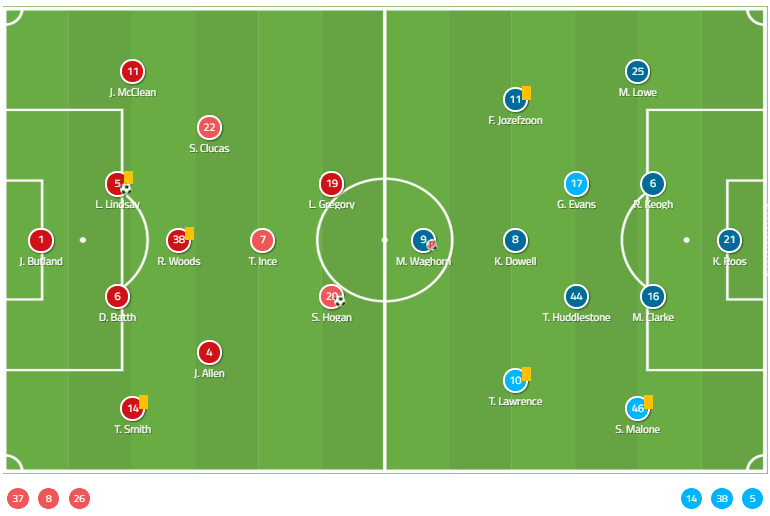
Meanwhile, Derby travelled to Stoke’s home ground with a 4-2-3-1 lineup. Kelle Roos remained in goal while Matt Clarke, Richard Keogh, Scott Malone and Max Lowe completed the back four.
Kieran Dowell positioned himself in the middle of the attacking midfielder trio with Tom Lawrence and Florian Jozefzoon occupied the wide spaces. Upfront, Martyn Waghorn led the line while Jack Marriott and Jamie Paterson gave Cocu two potential options on the bench.
Stoke’s style of play
Lining up in a 4-1-2-1-2 formation showed Jones’ clear intention of replicating Luton’s winning tactics to Stoke City. The first noticeable tactical point was the players’ attempt to create a three-man build-up on the edge of the final third. When in possession, two centre-backs Batth and Lindsay usually moved a bit wider from their original positions. Ryan Woods, who played in the role of a half-back, dropped in between them and created a passing triangle to counter Derby’s pressure.
In Lindsay, Jones got himself a natural ball-playing defender who is comfortable on the ball when it comes to passing and dribbling. The former Barnsley defender tended to dribble into the opposition’s half when he had the ball and laid it off to a midfielder. Woods could also take on that responsibility and linked up with Clucas and Allen upfront.
In terms of the stats, Lindsay had a few decent numbers to his name. He made a total of forty passes and completed 29 of them (with an accurate rate of 73%). He also registered thirteen long balls which eight of them reached its destinations (62%) and nine passes to the final third.
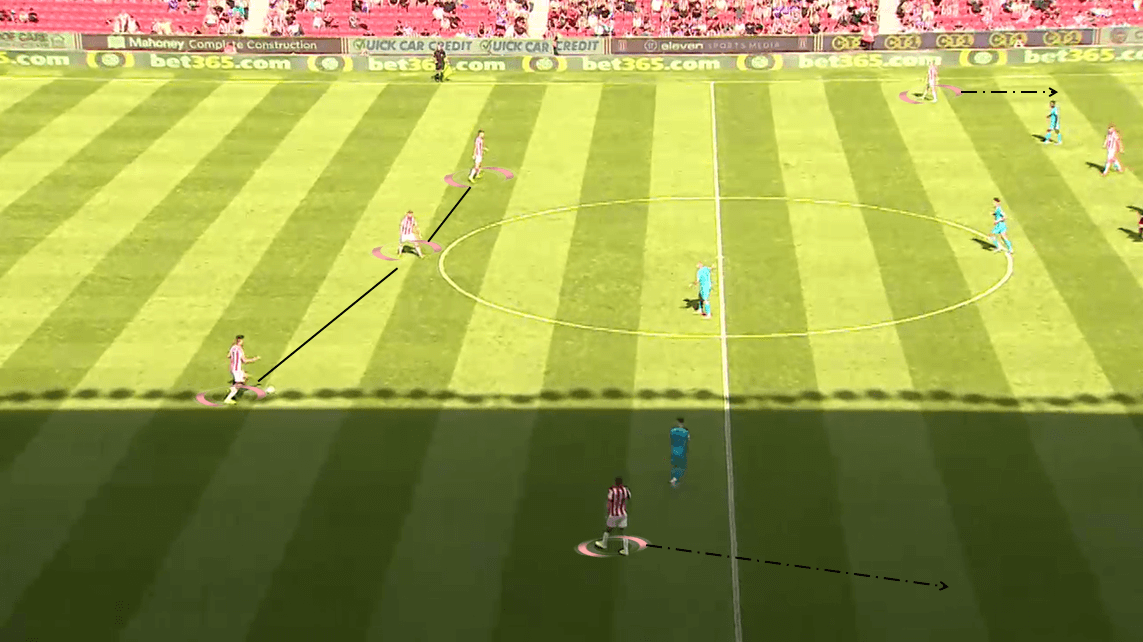
Meanwhile, two wing-backs could either overlap up the pitch to join the attack or staying deep and involve in the build-up. With Tommy Smith and McClean were two attacking wing-backs, with the latter were originally a winger, they chose to move into the final third. This gave them the advantage in numbers when they built their attacks and a method to approach the 16-yard box.
Stoke usually distributed the ball to both flanks for the wing-backs to dribble down the sides. They attempted to aim for the heads of Gregory and Hogan, who were good in the air on some occasions.
With Derby focused on defend the central area of the pitch, it created even more spaces for McClean and Smith to overlap. The shot below demonstrated the usual situation that happened in the game. After tried to build their attack on one side, Allen would pick up the ball and move away from the overloaded area.
There, he noticed McClean tried to overlap into the spaces on the left-hand side and were asking for the ball too. It’s also worth mentioning that no Derby players could step out of position and apply pressure on the Irish player as they were pinned down by his teammates. A long pass from Allen easily found him and McClean were able to approach the box with his run down that wing.
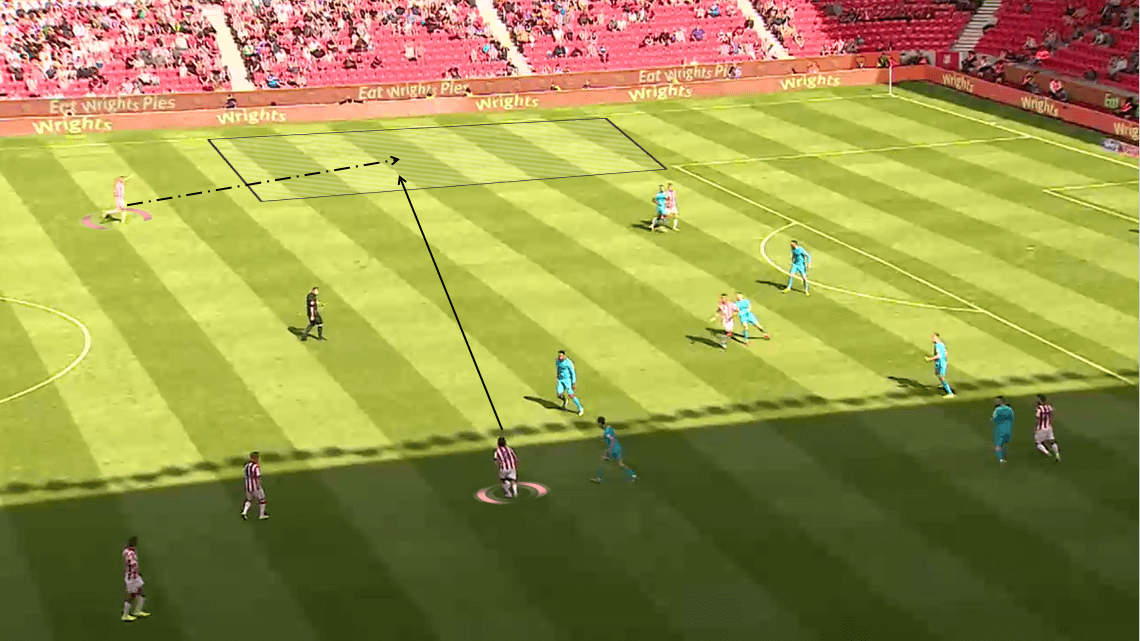
The players’ positioning on either flank of the pitch also contributed to their search for goals. Whenever a player controlled possession whether inside the half-space or wide area, at least two would come short and offer passing options. In the shot below, Tom Ince attracted one of Derby’s defenders to move out of his position.
Meanwhile, McClean came nearer to Ince and also dragged Huddlestone with him. This created spaces behind Ince’s back for Clucas to move in and ready to receive a pass. Those quick combinations and smart positioning from Stoke happened occasionally on the pitch and created problems for Derby when they defended.
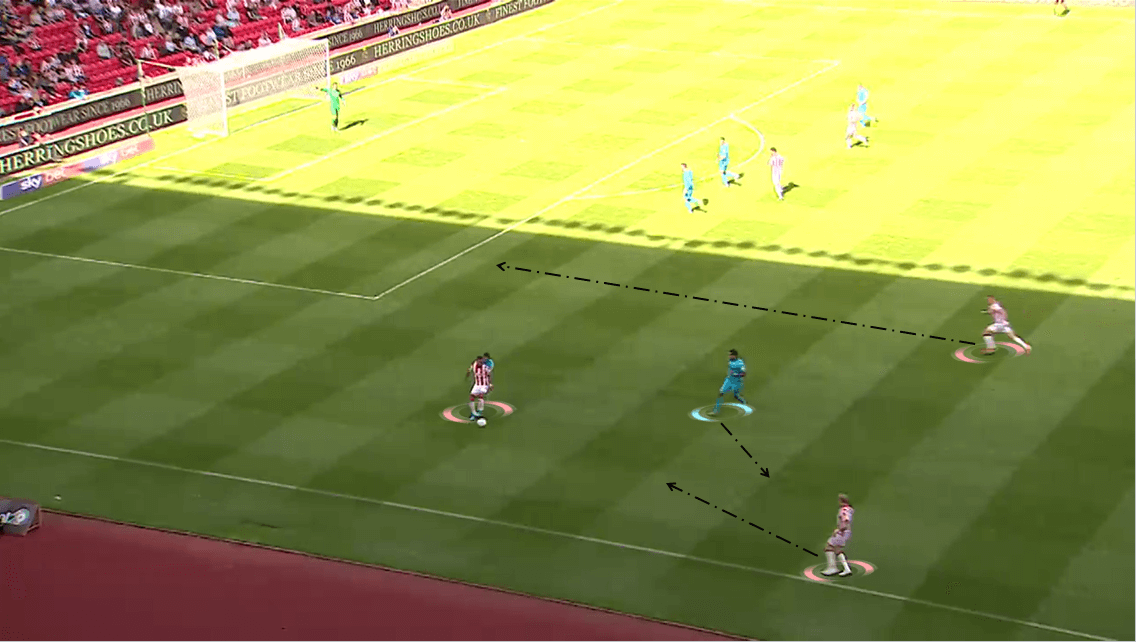
They also had another way of getting the ball into Derby’s half through long balls. As mentioned, Lindsay and Batth could pick out the strikers’ run by placing passes into the space behind the opposition’s defensive line. It reduced the time of building their attacks and allowed them to focus on converting the chances.
One of those situations eventually led to Stoke’s second goal of the game. Butland received the ball from his defenders and kicked the ball up the pitch. It fell into Gregory’s run, who sat on the shoulder of defenders, and he made his way through towards the 16-yard box. Hogan arrived a bit later on and converted Gregory’s pass into a goal.
Defensively, they pressed higher up the pitch using two pressing lanes. The first one was the strikers and the attacking midfielder as they attempted to disrupt Derby’s build-up. They usually followed the ball-carrier’s surround passing options while leaving him with little space to create short combinations. It forced him to make a backpass to Butland or used a long ball up the pitch.
Below, the three midfielders vacated the central area and would intercept passes or through balls came towards them. If Derby distributed wide, they shifted along with the ball and linked up with the strikers to create an overload. The only problem that they had was their shifting process occurred quite slow.
The trigger for them to shift was when the ball left either Clarke or Keogh’s feet. But it only took a few seconds for the ball to find Derby’s full-backs and Stoke’s two pressing lanes had to move towards it and create an overload at the same time. Even when they have done doing so, Max Lowe or Scott Malone would have dribbled up the pitch by then. They have to recover from their position and it took them more time to complete retreating into their half.
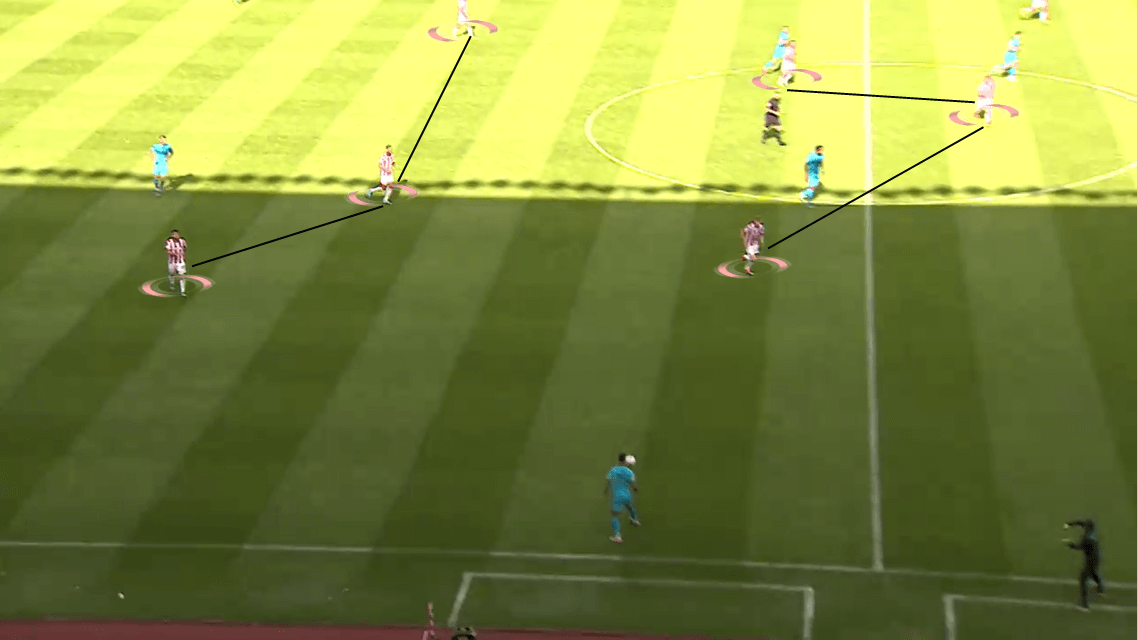
Inside their own half, they also created overloaded areas with the aim of winning the ball back. Their 4-3-1-2 defensive structure pushed a bit higher up while the players were still sticking to their position. Usually, the back four stretched wider and occupied the central area and the half-spaces at the same time.
Four central midfielders moved laterally across the pitch to screen the defence and combined with them to create an overload on that side. Woods stayed deepest and covering the spaces on his sides were Allen and Clucas. Ince could also drop in between the central midfielder and let Woods moved between the channel.
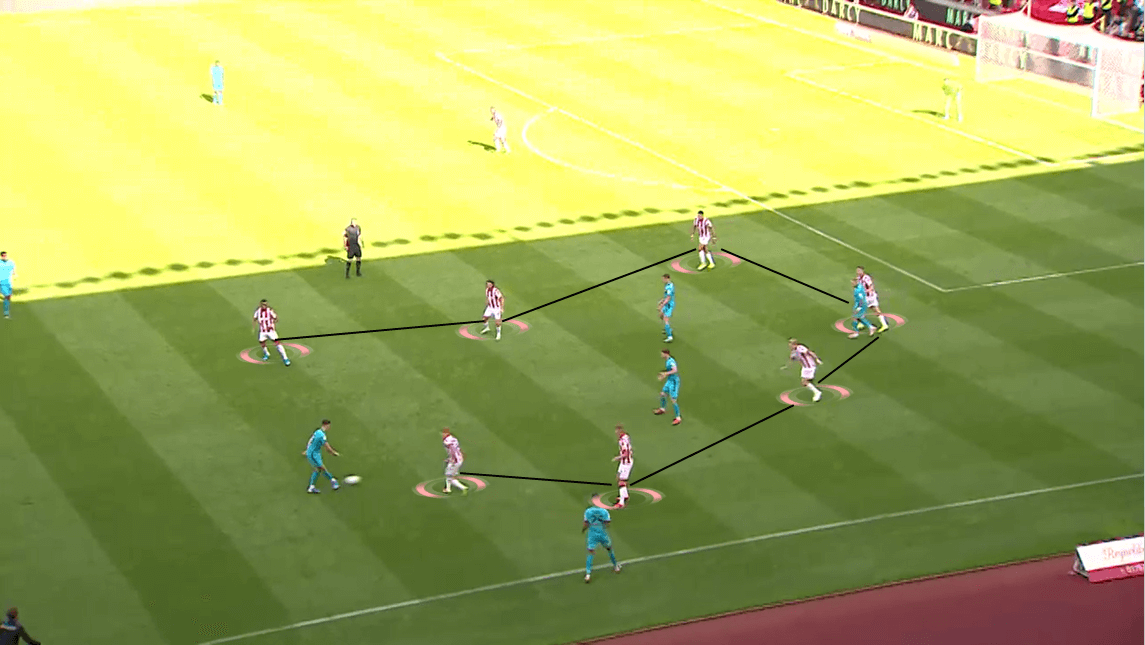
Their style of play basically relied on rapid turnovers and quick transitioning from defence to attack and in the opposite way. It required the players to have good positioning and spacial awareness to cover depth and support their teammates at the same time. Jones is still improving his players’ fitness to fit in his tactics, but he also needs to find a way to cope with the area of the field.
He tends to shape his team quite narrow and focus more on the central area. When the opposition move the ball wide, the shape would shift with the ball as mentioned. This accidentally creates spaces on the other flank and allows both wing-backs and wingers to capitalise and allows the opposite team to constantly change their attacking direction.
In most of Stoke’s defensive situations in the match, when the players were tracking back and covering depth, they left gaps being unoccupied. This invited Dowell and even the wingers when they cut inside to move in and receive the ball from Scott Malone and Max Lowe. Derby’s opening goal is a perfect example for this situation as the Everton loanee received the pass from Malone. He then found Waghorn on the shoulder of Lindsay using a pass.
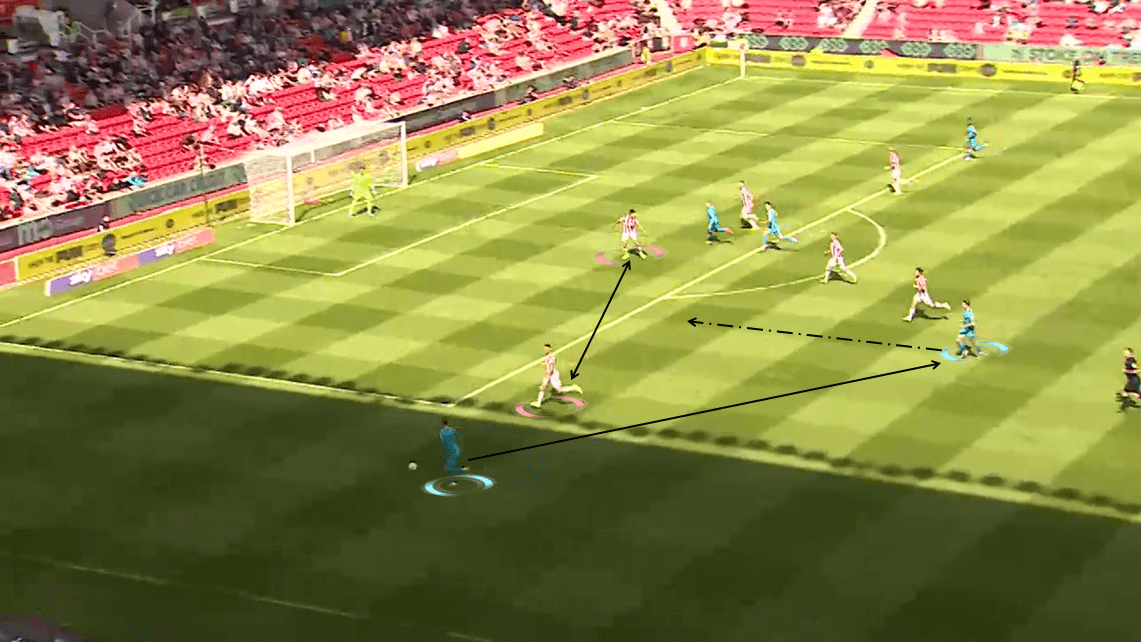
Derby’s style of play
When out of possession, Cocu adapted a 4-2-3-1 defensive shape and required his players to regroup. Rather than immediately counter-press the opposition with the aim of winning the ball high up the pitch, the players retreated to their half and filled in their positions. They stayed quite compact and prevent the opposition from making through balls in between the lines.
Furthermore, they would only apply pressure when the ball was coming towards them. While their teammates attempted to recover possession, the defenders and central midfielders followed Stoke’s attackers. They wanted to stop them from making runs towards the final third and turned into potential passing options.
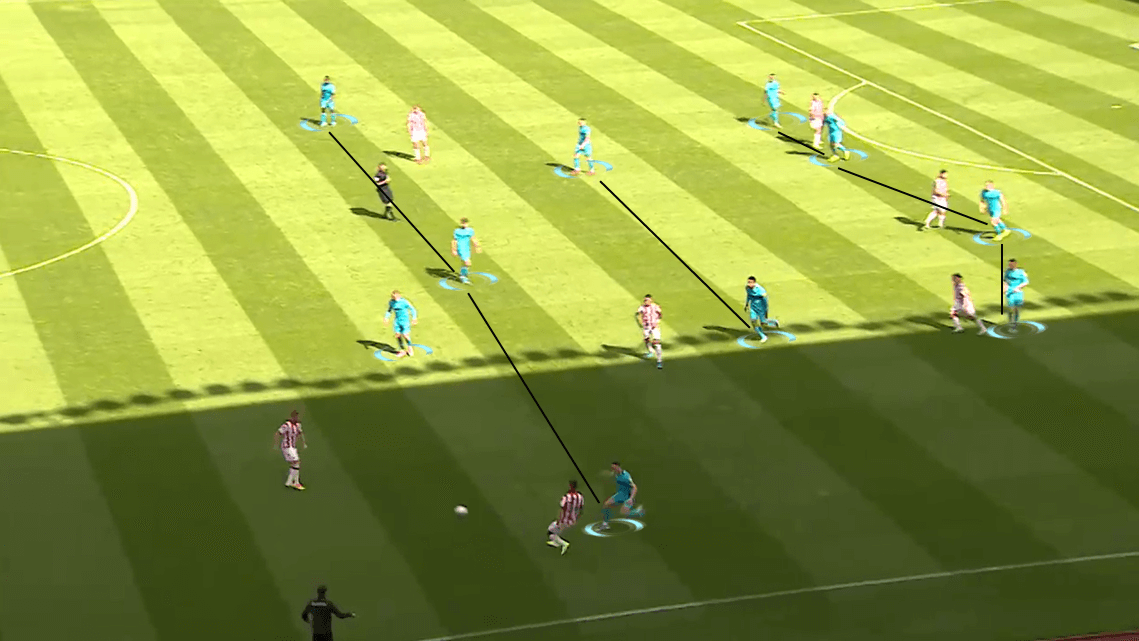
At times, their defensive structure could look similar to a 4-4-2 when Dowell moved higher and positioned near Waghorn. This showed their intention of getting the ball back inside the middle third and brought teammates into play. If they did manage to recover possession, the ball-carrier wouldn’t be suffocated easily as there would be at least three players making progressive runs and support him.
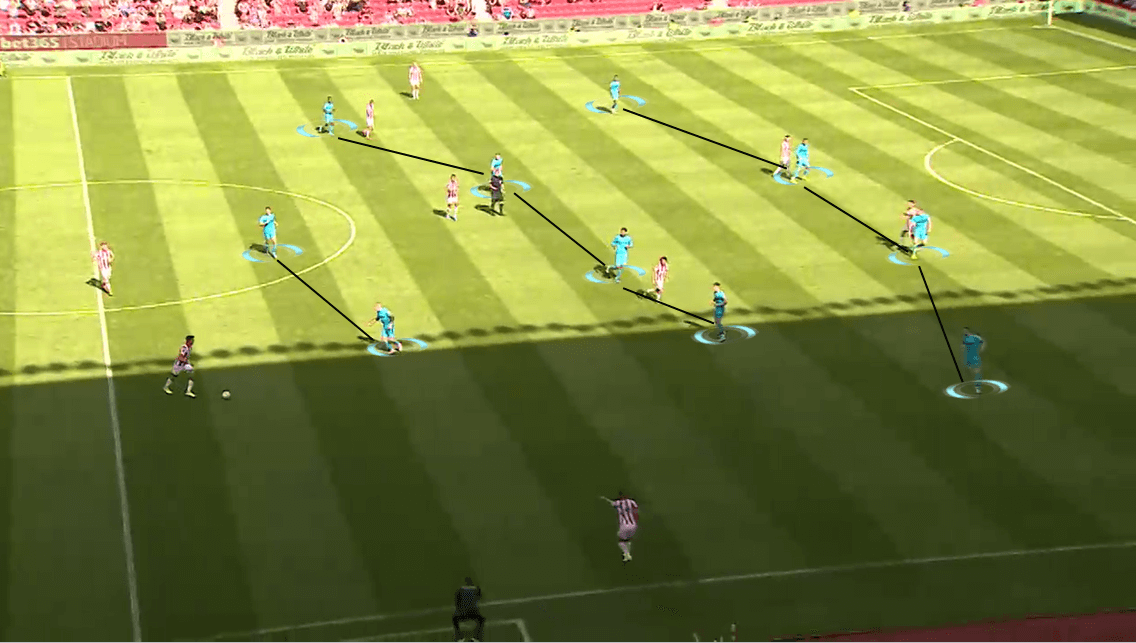
It doesn’t come as a surprise when most of Derby’s defensive duels occurred inside their defensive third and the middle half of the pitch. The density of the duels also focused more on both flanks, especially on the right-hand side. Lowe and Jozefzoon had to do more works as they have to deal with short combinations between Clucas and McClean.
With Stoke focusing on attacking down both wings, at times Keogh and Clarke even have to drift wide. Most of the Irish centre-backs’ duels happened inside the right half-spaces and only a few of them were found in the central area. The same thing happened with the former Portsmouth defender as he moved slightly to the left and supported Malone.
While the centre-backs were doing their dirty works, George Evans moved flexibly inside the centre and converted their position. He appeared a lot on both flanks of the pitch, winning second balls for Derby and started attacks using through balls. Dowell was also involved with a decent number of seven duels while completing 71% of them.
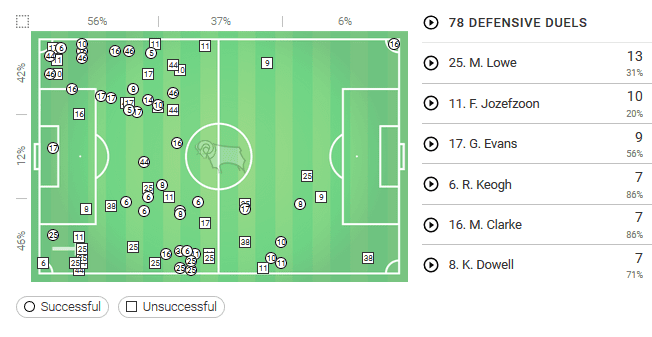
On the attacking side, Derby relied on penetrative passes being made from the defenders. In the first half, Evans occasionally dropped deep and formed a passing triangle with two centre-backs. This allowed the full-backs to move higher up the pitch and positioned themselves in the wide area.
The introduction of Krystian Bielik, who could both plays as a centre-back and a defensive midfielder, allowed them to approach with a different way. Bielik positioned in between Keogh and Clarke, became a focal point in Derby’s four-man build-up. Huddlestone now dropped a bit deeper and offered to bring the ball up the pitch. The Polish player could either dribble the ball himself or lay it to Huddlestone and leave everything to the veteran midfielder.
They created at least three passing triangles to counter against Stoke’s high press. Also, the involvement of four players also won them the numerical superiority against Stoke’s three players. If one decided to step out of the shape and mark Huddlestone, it would leave spaces available for Derby attackers to capitalise.
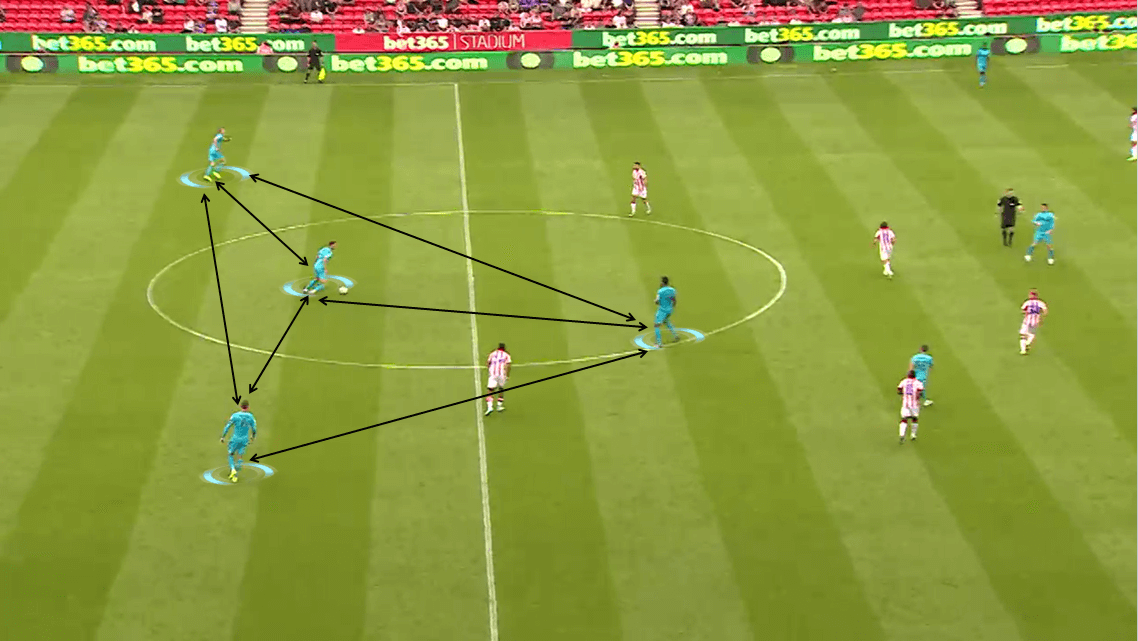
They were also a wing-oriented team with thirteen positional attacks came from the right-hand side. The combination between Lowe’s overlapping runs and Jozefzoon’s half-space movements usually caused troubles for Stoke’s defenders. They have to shift their players into the right-wing and attempted to win the ball back. But it would also allow them to change their attacking direction when they moved the ball out of the overloaded area.
The higher efficiency came from their attacks inside the central area, though. They reached an xG rating of 0.48 and managed to approach Stoke’s box more. Waghorn’s opening goal also came from an attack built centrally before passing the ball out wide for Malone.
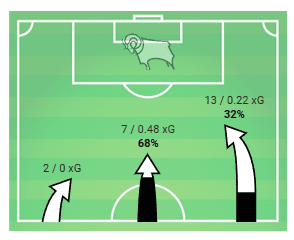
Speaking of Malone, he linked up quite efficiently with Waghorn in the match. When he overlapped, he tended not to sprint towards the box but would look for potential receivers. Meanwhile, the former Rangers striker positioned himself on the shoulder of Stoke’s defenders, waiting for a ball to come towards him.
Malone would pick him out using an early cross into the space behind Stoke’s defensive line and allowed Waghorn to sprint towards Butland’s goal. He could also centre his passes towards Dowell and Lawrence to utilise their creativity.
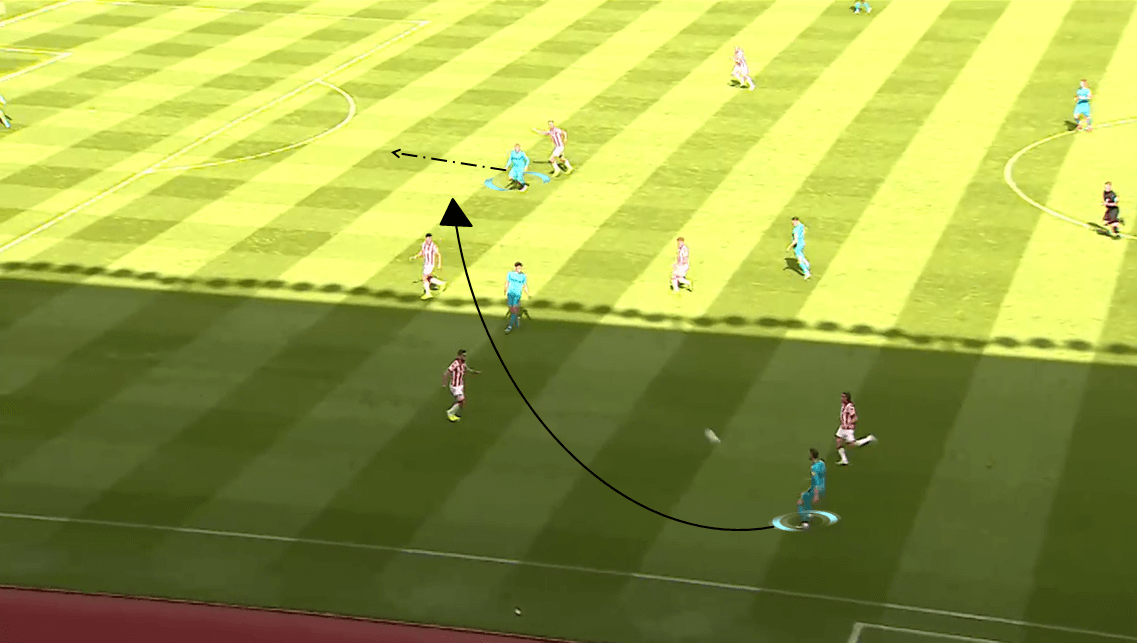
Conclusion
It was a very close battle against two quality teams, eventually, no side ended up with a win. Nathan Jones and Stoke are still looking for their first win of the season and they could take away the positive notes from this match. Along with the fact that his players are getting more familiar with his tactics, it wouldn’t take too long for them to secure their first three points of the season.
Although Derby managed to continue their unbeaten run, they did it in a hard way. But, on the other hand, the players clearly showed what Phillip Cocu wanted his side to do in the match. Their signings are adapting to the team and some of Derby’s players also picked up their form from last season. This will be big momentum for The Rams to push on and build on what they have done under Frank Lampard.
——————————————————————————————————

If you love tactical analysis, then you’ll love the digital magazines from totalfootballanalysis.com – a guaranteed 100+ pages of pure tactical analysis covering topics from the Premier League, Serie A, La Liga, Bundesliga and many, many more. Buy your copy of the August issue for just ₤4.99 here.




Comments